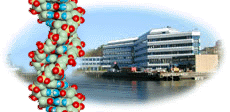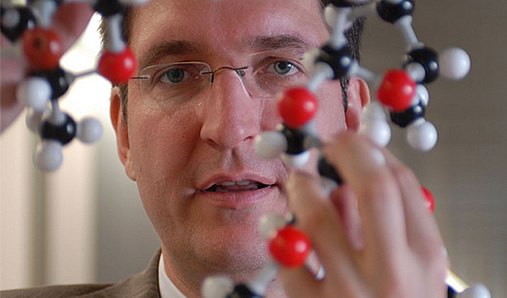by Ute Krengel, Department of Chemistry, UiO
This year’s Hassel lecturer has a sweet tooth: Peter Seeberger, director of the Max-Planck-Institute of Colloids and Interfaces in Potsdam, is a sugar expert. Not just any one expert; rumors have it that he is a solid candidate for a Nobel prize in Chemistry. But let’s start where it all took off. Personally, I can vividly remember reading his Science article in 2001 on Automated solid-phase synthesis of oligosaccharides. An amazing tour de force! To those of you who know little about sugars, this might seem trivial. After all, automated synthesis of peptides and DNA was invented decades ago. So what is so special about sugars? The thing is that these simple molecules, which are all around us and absolutely essential for life, are not so simple after all. Not only do sugars have a multitude of the same type of functional groups called hydroxyl groups, which each can form linkages to neighboring molecules – in addition these groups have to be connected ‘stereospecifically’, otherwise they will give rise to completely different properties. Sugars are in fact so tricky to synthesize that the first total synthesis of common table sugar in the laboratory, by Lemieux in 1953, was considered the Mount Everest of organic preparative chemistry, despite its low yield of 5.5% (and this not just because Hillary famously climbed Mount Everest in the same year). Around the year 2000 others were still struggling to produce other simple sugars – and here comes an individual who automates it all; using an old peptide synthesizer to assist his needs. So it was no wonder that the world took notice, and Seeberger’s was recognized with many prestigious prizes.
How fitting also that a sugar chemist is recognized as Hassel lecturer. After all, Odd Hassel, who received the Nobel prize in Chemistry in 1969, is well known for his structural work on cyclohexanes – molecules with very similar structures as many simple sugars.
Peter Seeberger is not just a brilliant scientist, but also an enthusiastic lecturer and innovator par excellence. I personally have been fortunate to attend one of his lectures, where he took us on a journey to develop a drug against malaria, using his modified peptide synthesizer as a tool. I learnt a lot in that lecture, and everyone did – not least about malaria!
The old machine is now optimized for the new purpose and sold as “The Glyconeer®” – the first commercial, fully automated oligosaccharide synthesizer. With this equipment, even 50-mers are now accessible to in vitro synthesis – enabling the generation of glycan arrays and the screening of sugar receptors. Behind this instrument stands one of Seeberger’s spin-offs, GlycoUniverse. Another spin-off, focusing on vaccine development, is just about to start operations. A plethora of infectious diseases can potentially be treated with sugar-based drugs and vaccines based on his synthetic technologies. The implications are enormous. I strongly recommend that you note the 18th and 19th of May on your calendars and enjoy the Hassel lectures – do not miss this opportunity!!!
Lectures:
Hassel plus 18.5. 14:00: “The Logic of Automated Glycan Assembly”
Hassel lecture 19.5. 11:00: “Preventing and Curing Infectious Diseases: Carbohydrate Vaccines and Continuous Flow Synthesis”
On popular demand, additional lectures will be given in Bergen (20/5), Trondheim (21/5) and Tromsø (22/5).

